It has been a seafood adventure on and while he has showcased the fine, fresh & local produce of the Sunshine Coast, we've also geared up to tap into mastering delicious fish - here's how!
Get grilling!
1. Turn the barbecue grill plate on to high and sprinkle with salt. This will increase the conductivity of heat. Apply a drizzle of oil over the salt.
2. Once the oil begins to smoke a little, it’s ready. Turn the heat down to medium.
3. Take your fish (in this case your cleaned salmon fillet) and place it on the grill with the presentation side on the grill first (the side which will face up on the plate when served). Ensure that you lay the fillet down away from your body to avoid any hot oil splashing towards you.
4. As the salmon begins to cook, a white line of cooked flesh will appear up the side of the fillet. For a perfect medium-rare result, turn the fish when the white line has risen approximately one-third of the way through the fillet.
5. Continue grilling until the white line on the OTHER side has risen approximately one-third of the way through the fillet.
Note: If you are concerned about overcooking the thinner part of the fillet, position the fillet on the edge of the barbecue with the thin portion of the fish hanging over the edge. This will stop the thin portion from continuing to cook while allowing the thicker portion to continue.
Crispy skin connoisseur
A popular restaurant technique for cooking fish is to pan-fry with the skin on, blasting the skin until it is nice and crispy, then finishing the cooking process off in the oven.
To prepare the skin...
Wipe this down with a paper towel and then run a knife across the skin to scrape off the last bits of water. If you know what direction the scales went, scrape the knife in the opposite direction to this.
“Wipe it off on a cloth and keep doing that three or four times,” he says. “And then with a sharp knife, very finely score it because when skin hits oil it curls up.”
To cook it...
1. Preheat the oven to 180°C. Pour some olive oil into a pan, add some salt and heat until just before it reaches smoking point.
2. Add the fish, skin side down. Place a clean pot gently on top of the fish fillet to flatten it down (it will start to curl up once the heat hits the connective tissue), lifting this off after about 30 seconds.
3. Let the fish cook at the high temperature, skin side down, until the colour of the flesh changes. Resist the temptation to poke and prod it. This is how Peter describes the colour change: “When you see the white band [in the case of white flesh fish] where the flesh changes colour and goes white [as it cooks], when it reaches about 1cm to 2cm into the top of the fish, it’s ready.”
4. At this point pop the fish into a moderate oven for four to five minutes. When you take it out of the oven, flip it so the flesh side gets a minute on the direct heat of the pan to get some colour, then serve it, skin side up.
A couple more things...
• Because the temperature gets quite high, Peter says a stainless steel or black pan would be best – this will avoid the coating peeling off a non-stick pan.
• A thick piece of barramundi might need to be oven baked for 6 minutes. Alternatively a big piece of ocean trout might only need 3 minutes. Cook your fish according to taste. Get the recipe for this .
Get the recipe for this .

Poach perfect
Peter is a huge fan of the poaching method, particularly for salmon and ocean trout.
A good poaching liquid...
Is made of half fish stock and half verjuice, then lots of herbs, although nothing too strong. “A little bit of dill, some parley stalks, a few slices of onion, like I’m talking a few slices of onion, maybe a clove of garlic that’s just broken but not exuding too much flavour,” he says.
Bring this to the boil and let it simmer for a bit. Taste it to make sure the flavours are as you want them.
To cook
Preheat the oven to 180°C. Remove the skin from the fish. Place the fillets into a baking dish and pour over the poaching liquid (that has been simmering) so it’s half an inch above the fish. Cover this with a piece of baking paper. Cook it for four minutes (or to taste).
“It will be pink in the middle and that is when you say to people, experiment,” he says. “It’s up to you, if you want it cooked more, just leave it in longer.”
So how much pinkness is okay? The texture of the fish changes as it cooks. If the flesh is hard to cut through, chances are it’s still too raw in the centre.
Eat it
Enjoy it cold on a warm summer’s day with a pea and fennel salad, tomatoes with balsamic and fresh herbs, or a zesty mayonnaise. Eat it warm on a winter’s evening with some roast baby vegetables. Take the broth, strain it and add a little bit of crème fraiche to it for a sauce.
Bag 'n' bake
Peter says the idea of en papillote, which is French for 'in parchment', “is that you don’t lose a single drop of flavour, or the natural juices”.
To prepare
Get a piece of baking paper and cut out a big circle. As a guide, for a 200g fillet of snapper "you’d cut the circle the size of a medium frying pan".
Lightly grease the paper, then put your fish in. Add some flavour (some capers, onion etc), add a knob of butter and a tablespoon of stock. Then, fold the paper into a half moon. A good tip here is to use egg white as a glue to seal the paper ‘bag’.
To cook
Preheat the oven to 180°C to 200°C.
Place the fish parcel on a baking tray and pop into the oven. Cook it for about 8 to 10 minutes, or to taste. The butter and stock will combine and produce steam, which will cook the fish in the ‘bag’ – assuming there are no holes for the steam to escape.
“…if you really want to get fancy you put the fish on the plate, you put the liquid in a pan, season it, finish it off with a little bit of butter to bring it all back together, a dab of crème fraîche then serve the sauce,” Peter says.
And if you are cooking a thick piece of blue eye cod, this might take 12 to 15 minutes.
Peter Kuruvita explores fresh & native ingredients in his series 8:30pm Wednesdays on SBS Food or stream it on SBS On Demand. Visit the for more details, recipes and guides.






